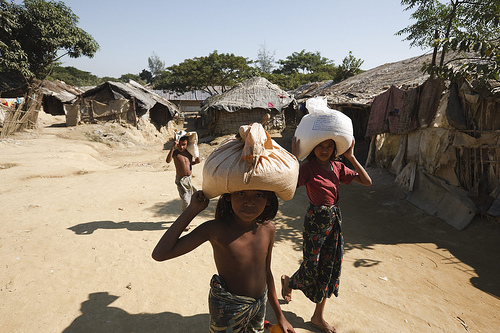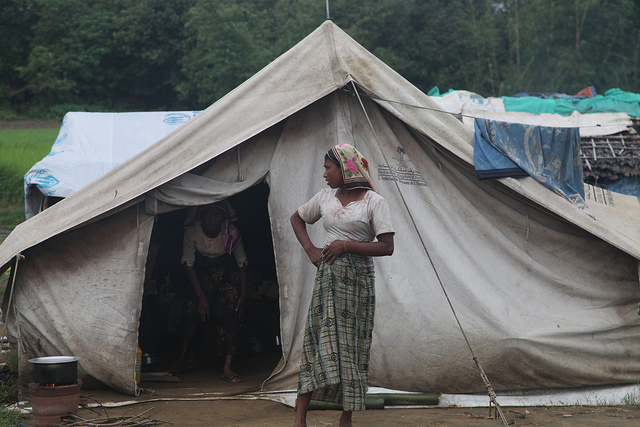
Rohingya refugees carry rice distributed by WFP to their house in Nayapara camp. UNHCR – S. Kritsanavarin – Nov 2008
Violence against Rohingya Muslims has remained relatively steady this month. The attacks usually seem to take the form of either direct assault to a person or group, or by destroying or defacing Muslim owned businesses and landmarks. On November 11, a Rakhine extremist who is reportedly the leader of “Hitler Gang” of Maung Daw attacked a shopkeeper when he did not give him cigarettes fast enough. His friends soon joined him and the group vandalized the shop and left practically nothing undestroyed.
The acts of violence have led to groups attempting to flee the country by boat, generally to Malaysia or Thailand. These journeys are very dangerous. On November 2, a boat headed to Bangladesh with about 70 Muslim Rohingya capsized and sank off of the west coast of Burma. During that week, as many as 1500 people fled the country, because monsoon season was over and the seas were calmer. There is evidence that authorities from inside and outside of the country are facilitating this exodus, as the use of bigger and sturdier boats has become more widespread and the cost for departure has been lowered. The migration of the Rohingya is being considered one of the biggest movements of boat people since the Vietnam War. Even if the method of transportation has become safer, the involvement of official authorities does signify that there is a preference to drive the group out of the country rather than come up with a solution for the conflict.
Though the authorities may want the Rohingya to leave, the ongoing tensions and violence have caused neighboring countries to make access much more difficult. Earlier this month, Bangladesh decided to close its border with Burma, blocking any Rohingya refugees from entering because of the pressure it was putting on the country. They also proclaimed that they would be taking legal action against any “illegal infiltrators and those giving them shelter,”[1] thereby discouraging people already living in the country from offering assistance to refugees. The inability for the Rohingya to live securely within Burma or to travel safely to new destinations puts them in an extremely vulnerable position that human traffickers and smugglers have started capitalizing on. Human trafficking of Rohingya has started to become a problem, and will only get worse as their situation becomes more desperate.

This month also featured a visit from the Organization of Islamic Cooperation, an organization that seeks to protect Muslim interests worldwide and act as a collective voice for the Muslim world. They arrived in Burma on November 13, and were scheduled to meet with top government officials in the country’s capital city, Naypyidaw to discuss solutions to the crises that Muslims are facing. They also visited Rakhine state to see the camps where Rohingya Muslims are being held. The secretary general of the OIC, Ekeleddin Ihsangolu, said that the experience of visiting with those in the camps brought him to tears. The OIC group was met with protesters in both Rangoon and Sittwe, but they considered the trip to be a success because the invitation came from the government, who has remained largely silent about the attacks on Muslims in the country.
Violence was expected during the visit, as well as after, and this has proven to be an accurate prediction. On November 19, 18 Rakhines led by an extremist faction of Buddhist monks started destroying a mosque, a madrassa, and its minaret in Kyaukphyu. This attack was allegedly in response to the OIC visit. On the same day, a Rohingya man from Buthidaung Township was beaten with sticks and swords by a group of 20 Rakhinese people. Some passers-by noticed him after the attack and took him to the police, who then directed him to the government hospital. Upon his arrival there, the nurses then beat him with their slippers and forced him to leave, saying, “Ask your father OIC to give you treatment!”[2] No legal action has been taken against the group or the nurses at the hospital, despite the authorities being notified. Other incidents of violence have occurred since the visit, all reportedly in response. Rohingya communities have expressed concern that more attacks will be triggered soon in the north of Rakhine state.
There is also increasing evidence that the government is actively involved in the coordination of anti-Muslim violence. On November 22, a group of 120 monks associated with the 969 movement went to the administration office of Thingangyun Township to ask renovations on a madrassa cease. Permission had been granted by the municipal deparment for the renovations to occur, but the monks threatened the authorities and in the end, the work on the madrassa was stopped. A picture taken on this day shows one of the monks holding a walkie-talkie, which are allowed to be used by police, military, and intelligence departments only.
On November 20, the United Nations General Assembly Committee on Human Rights passed a resolution urging the government of Burma to give the Rohingya citizenship, and to crack down on the Buddhist violence against them and other Muslim groups in the country. The Burmese government rejected this resolution, stating that they don’t recognize the existence of a Rohingya minority. They continued to say that they would consider granting citizenship to “Bengalis” under the 1982 Citizenship Act, which does not include the Rohingya on the list of minority groups.
In his report released last month, UN Special Rapporteur Tomás Quintana said that the government is showing greater willingness to investigate human rights violations going on around the country, including those committed by security forces. As well, their invitation to the OIC to visit the country and see the camps in Rakhine state would also appear to represent progress in terms of their openness to what has been happening around the country. However, their reluctance to grant citizenship to the Rohingya without calling them “Bengalis” and the mounting evidence that they are actively involved in anti-Muslim violence contradicts any apparent strides they have made. It seems that such progress has been purely cosmetic.
There has definitely been more media attention paid to the situation in Burma, and with mainstream institutions such as the United Nations and the United States Holocaust Museum commenting on what has been going on, awareness of violence is spreading. Though this definitely positive, there is still cause for concern in the way in which the violence is covered. The attacks on Muslim communities are often labeled as “sectarian” or “communal” violence, which implies that both sides share an equal role in what has been going on, when this is not the case. These labels help to justify anti-Muslim campaigns and take focus away from the government’s implicit and explicit roles in the violence. Attributing the tensions to “sectarian” or “communal” violence also deeply simplifies the roots of the conflicts and ignores the structural problems that must be addressed.
